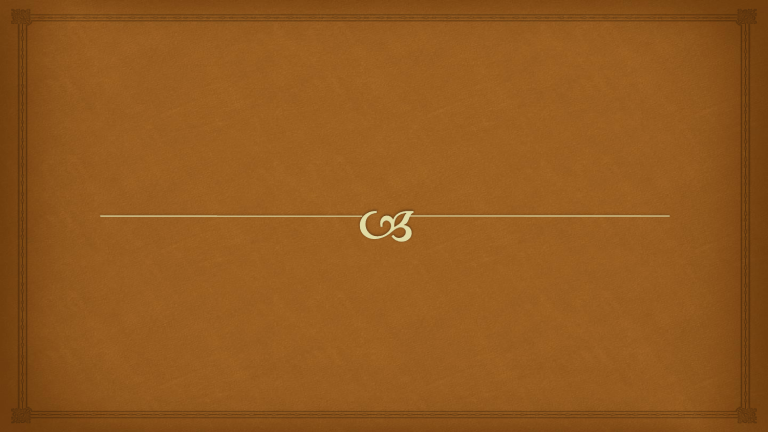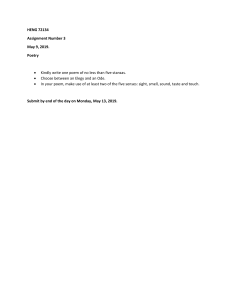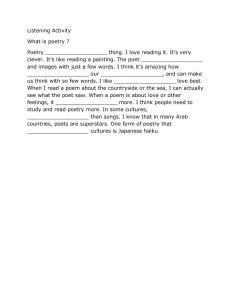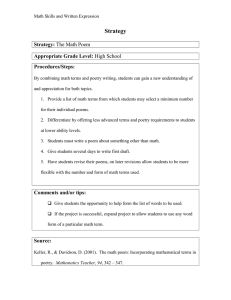
By: LEWIS CARROLL By: LEWIS CARROLL Twas brillig, and the slithy toves Did gyre and gimble in the wabe: All mimsy were the borogoves, And the mome raths outgrabe. “Beware the Jabberwock, my son! The jaws that bite, the claws that catch! Beware the Jubjub bird, and shun The frumious Bandersnatch!” He took his vorpal sword in hand; Long time the manxome foe he sought— So rested he by the Tumtum tree And stood awhile in thought. And, as in uffish thought he stood, The Jabberwock, with eyes of flame, Came whiffling through the tulgey wood, And burbled as it came! One, two! One, two! And through and through The vorpal blade went snicker-snack! He left it dead, and with its head He went galumphing back. “And hast thou slain the Jabberwock? Come to my arms, my beamish boy! O frabjous day! Callooh! Callay!” He chortled in his joy. Twas brillig, and the slithy toves Did gyre and gimble in the wabe: All mimsy were the borogoves, And the mome raths outgrabe. What is happening in the Poem? Twas brillig, and the slithy toves Did gyre and gimble in the wabe: All mimsy were the borogoves, And the mome raths outgrabe. 'Brillig' means four o'clock in the afternoon, the time when you begin broiling things for dinner." POETRY ANALYSIS POETRY ANALYSIS Poetry is from the Greek word “poiein” means “to make”. POETRY is a type of literature that aims to evoke an emotional response in the reader through language chosen and arranged for its meaning, sound, and rhythm. 3 Types of Poetry Lyric Narrative Dramatic Lyric Poetry Lyric poetry uses song-like and emotional words to describe a moment, an object, a feeling, or a person. Lyric Poetry Lyric is from the Latin lyricus, meaning of/for the lyre. These short poems were originally accompanied by music. Examples Elegy Haiku Ode Sonnet ELEGY a reflective poem to honor the dead Elegy Haiku Ode Sonnet O Captain! My Captain! by Walt Whitman Examples Elegy Haiku Ode Sonnet Examples Elegy Haiku Ode Sonnet HAIKU a seventeen-syllable poem that uses natural imagery to express an emotion HAIKU HAIKU ODE an elevated poem that pays tribute to a person, idea, place, or another concept ODE an elevated poem that pays tribute to a person, idea, place, or another concept SONNET a descriptive fourteenline poem with a specific rhyme scheme WILLIAM SHAKESPEARE He is an English playwright, poet and actor; regarded as the greatest writer in the English language and the world's famous dramatist. WILLIAM SHAKESPEARE He is England's national poet and is known as the "Bard of Avon". In total, Shakespeare published 154 sonnets in 1609. SONNET a descriptive fourteenline poem with a specific rhyme scheme SONNET a descriptive fourteenline poem with a specific rhyme scheme SONNET a descriptive fourteenline poem with a specific rhyme scheme Narrative Poetry This poetry tells a story. It is often set to music as ballads and usually of human interest and include epics, or long stories. BALLAD a composition in rhythmic verse suitable for singing EXAMPLES • Ang Huling El Bimbo • Alumni Homecoming Edgar Allan Poe best known for his poetry and short stories, particularly his tales of mystery. He is widely regarded as a central figure of Romanticism in the American literature. Narrative Poetry Lyric poetry uses song-like and emotional words to describe a moment, an object, a feeling, or a person. Narrative Poetry Edgar Allan Poe's "The Raven" is narrated by a grieving man who, over the course of 18 stanzas, describes his mysterious confrontation with a raven and his descent into despair. EPIC a lengthy poem that tells a story of heroic adventures EXAMPLES BEOWULF BIAG NI LAM-ANG THE ODYSSEY Dramatic Poetry also known as dramatic monologue, is meant to be spoken or acted. Dramatic poetry also tells a story. POETRY ANALYSIS is examining the independent elements of a poem to understand the literary work in its entirety. POETRY ANALYSIS SMILE Structure, Meaning, Imagery, Language & Emotion STRUCTURE Stanza Rhyme Scheme Perspective STANZA 1 – Monoku 4 – Quatrain 2 – Couplet 5 – Cinquain 3 – Triplet 6 – Sestet RHYME SCHEME ABBA, CDDC, EFEF, GGHH MEANING Describe the SUBJECT What is it all about? How do you know? IMAGERY Use of Figures of Speech: Simile, Metaphor, Personification, etc. LANGUAGE Use of Literary Devices: Repetition, Alliteration, Assonance EMOTION Theme Topic EMOTION Theme: One Word; General Idea Topic: One Sentence EMOTION Theme: Love Topic: One sided love hurts a lot. REQUIREMENT Make an Analysis of your classmate’s poem. A4, Handwritten


